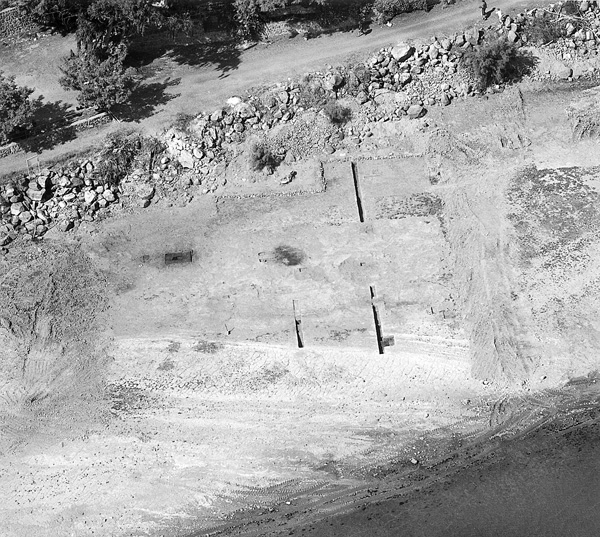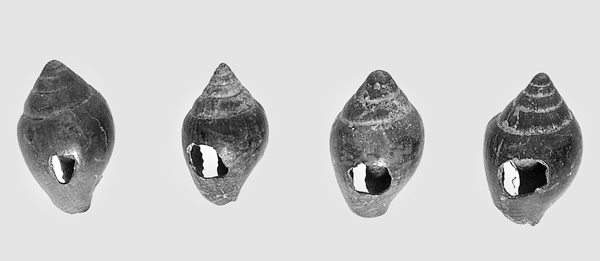Ohalo II
INTRODUCTION
Excavation at Ohalo II in 1991 continued the work commenced in 1989 and 1990. Three additional field seasons were conducted in 1999–2001. The new work was directed by D. Nadel on behalf of the Zinman Institute of Archaeology of the University of Haifa. Based on the material remains (flint tools) retrieved from these excavations, the site is assigned to the very beginning of the Epipaleolithic period.
Trenches totaling over 100 m in length were excavated. The underlying lacustrine layers are composed of clay, sand, and silt, representing one of the final stages of the northern facies of Lake Lisan. In the eastern and western sectors of the site a sequence of three major depositional units was revealed: unit I, post-occupational lacustrine layers; unit II, in-situ archaeological features and related sediments; and unit III, pre-occupational lacustrine layers—the Lisan Formation. Unit I was eroded in the central area of excavation. The geological observations and analyses indicate that the site was located on the beach of a fluctuating lake. It was inundated several times, and occupation episodes took advantage of the low-water intervals. After the site was completely abandoned, it was immediately submerged below calm, relatively deep water. Fine sediments sealed the site for millennia. The oxygen-poor conditions prevented the decomposition of the organic materials, thus preserving unique elements rarely found at contemporaneous or even later sites.
EXCAVATION RESULTS
THE CAMP. Excavations in the central area revealed the remains of a fisher-hunter-gatherers’ camp covering at least 2,000 sq m. It is comprised of in-situ floors of six brush huts, a grave, concentrations of hearths, and small installations. The brush hut remains are the oldest of their kind ever reported. The full contours of five oval huts were traced by following a dark line of burnt wood and other plant remains or by documenting the limit of the dark inner anthropogenic sediment, which differs from the natural bedrock in terms of matrix and contents. The floors of brush huts 1

The thickness of the occupation layer within each hut was 10–30 cm in the center, becoming much thinner towards the walls. The layer was always dark, with high densities of charcoal, bones, and flint. In five huts there were no discernible sub-layers within the fill, though local lenses of lighter sand or ash were observed. Thus, it is suggested that the accumulation of debris in each hut represents one floor with continuous occupation. Only in hut 1 was it possible to distinguish three successive floors separated by layers of silt/sand, in most places 3–5 cm thick. On its second floor, a large flat basalt stone used for grinding cereals lay horizontally. It was placed on a lens of yellow sand brought into the hut, and several small pebbles were set in the sand to secure it. On the bottom floor, the world’s earliest known remains of grass bedding were preserved. The bedding was composed of a single species, Puccinellia c. convoluta.
Six concentrations of hearths were discovered between the huts. The larger ones (e.g., loci 7
Another concentration of material remains (Ohalo II South) was discovered some 130 m to the south of the central area. No in-situ features were recorded, apart from one badly eroded hearth. Though their densities were lower, the flints and animal bones found in the southern area were similar in their characteristics to those found on the hut floors and in the hearth ashes of the central area.
THE GRAVE. One grave of an adult male was found (locus 5). The man was buried in a shallow pit, supine, legs flexed, and hands folded on the chest. The head lay over four stones on the northern side, the face turned to the east. A simple basalt hammerstone lay between the legs, near the pelvis, and a small polished gazelle bone with a series of incisions was found behind the head. About 1 m to the east was a circle of one layer of stones lying horizontally. No similar installations were discovered at the site. A flat piece of limestone, 20 cm long, stood upright along a north–south axis, 25 cm to the east of the circle. The edge set in the ground had been bifacially flaked to create a crude sharp end. Alongside the stone was a large, complete flint blade (7.5 cm long). It appears that the stone circle, the upright sharpened stone, and the large blade located near the grave comprised a single unit, unique at the site, possibly a grave complex with the orientation of several elements clearly indicating north and east.
DATE. The site was dated by over 40 14C assays measured by four laboratories. All the samples were of charcoal retrieved from the excavated loci. In addition, three wild barley seeds were separately dated by the Oxford AMS system. Most of the dates overlap, ranging between c. 18,000 and 21,000

THE FINDS. Botanical Remains. The most remarkable aspect of the site is the excellent preservation of the plant remains. So far, almost 90,000 seeds and fruit pits have been identified, belonging to over 100 species of trees, shrubs, grasses, and algae. The assemblage includes a wide variety of edible species, such as fruit and cereals, indicating that plant food from the forest, grasslands, and lakeshore environment was collected throughout the year. This is a rare case in which the vegetal components of the diet and the seasons of occupation of the camp can be directly reconstructed from the plant remains. Wood was brought to the camp for hut construction, fuel, and the manufacture of a variety of implements.
Faunal Remains. Fish comprise the most abundant faunal remains at the site, mainly of the Cyprinidae and Cichlidae families. Hundreds of thousands of these were retrieved from all loci, with all skeletal parts represented. Thousands of mammal bones have been studied so far; the most common are gazelle leg bones, though other elements such as mandibles and horn cores were also found. In much lower frequencies appear fallow deer, fox, and hare; other species are rare. Apparently many of the larger animals were butchered elsewhere, and only select body parts were carried to the site. The smaller animals include the common field vole, Tristram’s jird, the European hedgehog, the black rat, and the house mouse. Most of these remains were found in hut 1. The identified bird bones, 1,352 in number, form the largest sample ever studied for a prehistoric site in Israel. There are 19 families, 48 genera, and 83 species represented, with the Great Crested Grebe being by far the most common. In general, waterfowl comprise the largest group, followed by diurnal and nocturnal birds of prey. Birds were hunted for consumption, but probably also for their feathers and talons.
Flint Artifacts. The rich flint assemblage includes all stages of the reduction sequence. Cores are usually small with one oval striking platform for bladelet manufacture. Bladelets are prolific at the site, and many are twisted. The most common tools are finely retouched bladelets. Typical Kebaran microlithic types are rare, but several backed and truncated types are present, including proto-triangles. Burins were retrieved in small numbers, and scrapers are very rare. Flints were knapped in all the brush huts, and around most of the hearths. Current refitting studies will provide additional technological and behavioral data.
Basalt and Limestone Artifacts. Basalt and limestone were shaped into several types of implements. The most common was a simple artifact made by creating two opposed notches on an oval pebble. These were probably used as fishing-net sinkers, and as such are the oldest of their kind known from the region. The wealth of fish bones and the remains of charred cords support this suggestion. The assemblage includes large numbers of flakes and fragments, but very few standard tools. Also found were several fragments of shallow bowls.
Wood Artifacts. One large piece of wood, of an as yet undetermined function, was found in hut 15. Several small implements were also recovered. Outstanding is an incised piece that is similar in shape, size, and incisions to the incised gazelle bone exposed in the grave.

Bone Artifacts. Polished bone tools are numerous. There are several complete specimens, mostly simple points made of long gazelle bones, as well as dozens of shaft and point fragments, most probably from the same type. Also found were some very small specimens that perhaps functioned as needles or fishing hooks.
Beads. Two types of Mediterranean shells were used as beads. The most common is Dentalium, from which hundreds of tiny beads (2–3 mm in diameter) were cut. None of these were found on or near a skeleton (as in several Natufian graves), but were scattered throughout the camp. In addition, dozens of pierced Columbella rustica shells were recovered, again not concentrated in any particular location.
SUMMARY: CAMP LIFE
The Ohalo II camp was located on the shore of a fluctuating lake. The inhabitants of the site were a small group living in simple brush huts. They encamped at the site several times, for about a year each. It is unknown how many of the excavated huts were occupied in each event. Food was plentiful; the inhabitants gathered plant food from the surrounding environment and fish from the lake, and hunted a variety of mammals and birds. They had long-distance connections, as can be deduced from the presence of Mediterranean and possibly even Red Sea shells. A variety of food remains was preserved in each hut, and flint knapping took place in every hut as well. However, there are differences in certain details of the huts; for example, the proto-triangle type of microlith was found in only two huts, the relative frequencies of animal bones contained therein vary, and the birds show pronounced differences in species diversity. Daily activities took place in each hut and around the open-air fireplaces, with differences that could reflect “familial” preferences or seasonal activities. The inhabitants buried their dead in the camp. They also decorated themselves with Mediterranean shell beads, and probably used the incised bone and wood items as ornament or for ritual purposes.
DANI NADEL
INTRODUCTION
Excavation at Ohalo II in 1991 continued the work commenced in 1989 and 1990. Three additional field seasons were conducted in 1999–2001. The new work was directed by D. Nadel on behalf of the Zinman Institute of Archaeology of the University of Haifa. Based on the material remains (flint tools) retrieved from these excavations, the site is assigned to the very beginning of the Epipaleolithic period.
Trenches totaling over 100 m in length were excavated. The underlying lacustrine layers are composed of clay, sand, and silt, representing one of the final stages of the northern facies of Lake Lisan. In the eastern and western sectors of the site a sequence of three major depositional units was revealed: unit I, post-occupational lacustrine layers; unit II, in-situ archaeological features and related sediments; and unit III, pre-occupational lacustrine layers—the Lisan Formation. Unit I was eroded in the central area of excavation. The geological observations and analyses indicate that the site was located on the beach of a fluctuating lake. It was inundated several times, and occupation episodes took advantage of the low-water intervals. After the site was completely abandoned, it was immediately submerged below calm, relatively deep water. Fine sediments sealed the site for millennia. The oxygen-poor conditions prevented the decomposition of the organic materials, thus preserving unique elements rarely found at contemporaneous or even later sites.
